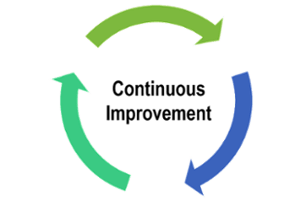"Kaizen" is a Japanese word that means “continuous improvement.” The western world has known the concept for over 30 years now. But very few teams and even fewer companies truly accomplish it.
Why is this? We would say because frankly, it’s too hard to do. People resist dirty little words like discipline, maturity, and process. These are words that have been used for years, yet they seem to add more work to their already busy days. Worse yet, not only does the “process” feel like it slows people down, they have to sit in meetings to talk about it. Heck, no wonder it’s such a hard topic!
 But the essence of Kaizen is really “continuing to get better.” It doesn’t say that you need to write a book to do so. It certainly doesn’t say “make it harder.” So how do you make it easier to get better every day? One way is to take away the blank page of getting started while at the same time making it very simple to create repeatable processes, sets of tasks, and checklists. It takes minutes to build a practice that you want the team to use. It takes seconds for them to choose from a gallery that automatically adds the work to your overall plan. They merely assign it out and track it. The team members simply complete their work queue and almost without thinking about it you are following a process. Once you finish one iteration of that activity, you can update it in the gallery so it can be better next time.
But the essence of Kaizen is really “continuing to get better.” It doesn’t say that you need to write a book to do so. It certainly doesn’t say “make it harder.” So how do you make it easier to get better every day? One way is to take away the blank page of getting started while at the same time making it very simple to create repeatable processes, sets of tasks, and checklists. It takes minutes to build a practice that you want the team to use. It takes seconds for them to choose from a gallery that automatically adds the work to your overall plan. They merely assign it out and track it. The team members simply complete their work queue and almost without thinking about it you are following a process. Once you finish one iteration of that activity, you can update it in the gallery so it can be better next time.
Let’s look at how a marketing department might use this approach in Coras for managing their yearly user group conference. This is a big event that is critically important to the company so they want it to go as smoothly as it can. The manager of the event would go to Coras and create a group of team members that are going to be helping with the event. They would then look at what needs to get done in order for the company to be ready for the event. They would bring up their mind map and think about the major things that need to get done for the event to be successful (think minutes). They would then likely break down the work and assign team members to manage their part of the work (again minutes). They would click on the gallery and pull down anything that is already available to use (think seconds). If this is the first year, then the team will likely brainstorm the activities in a simple mind map-like interface that allows them to easily layout the work (think minutes). The team would come together, and ensure they feel like they have a good start on the items they need to manage. They are likely wrong so they will be improving it every day as they learn more about the event (think seconds to minutes). They will run the event using Coras all along the way to ensure everyone knows what to do. Once the event is over, they will have many lessons that they want to ensure they do better next year. The team will tweak the overall event plan to ensure they don’t forget these things next year and push it to the gallery. Now in a year when everyone gets back together to start planning the next great user group conference, they know exactly what to do. The go to the gallery and within seconds they have their team’s activities created, and they validate and assign the team.
Our marketing department now has a simple and repeatable approach to managing their events. They can learn from each event and ensure that they don’t forget important items. They also can rest assured that everyone in the team will know what is going on, and the roles they and tasks assigned to each team member. Getting better every day as they learn and grow as a team. Now that is Kaizen the easy way!